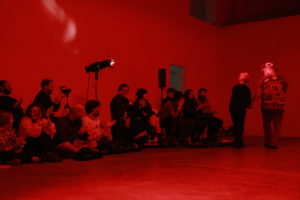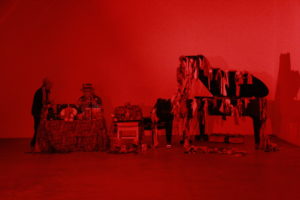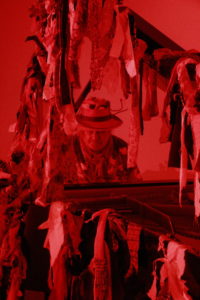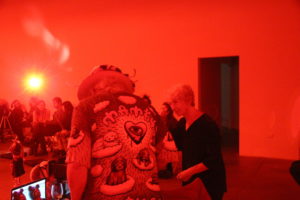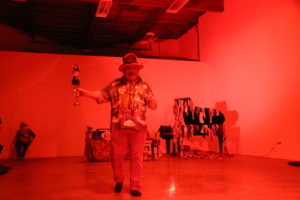illlummminnnatttionnnsssss!!!!!!! by Simone Forti and Charlemagne Palestine
- Illuminations discussion
Illuminations discussion with Simone Forti, Charlemagne Palestine, Aude Stoclet, Nina Queissner, Mara McCarthy, Jason Underhill, Paul McCarthy, Karen McCarthy, Alex Tuttle and Ethan Swan
January 17, 2018
(Edited remarks from a three hour conversation)
Charlemagne Palestine: Well, we’re talking about like, in the last days of 1970, just before the earthquake. Simone was friends with a whole lot of people who were living in Griffith Park somewhere. In January of 1971 there was a real big earthquake. It was like at 6 o’clock in the morning.
Mara McCarthy: A very classic time for an earthquake.
CP: It was really weird because I had this chime, one long industrial piece of iron in the middle of a big room, bigger than this room, and at 6 o’clock it started to ring because the earthquake was so strong.
MM: Where were you living when that earthquake happened, Simone?
Simone Forti: I’ve been trying to remember the name of it. I was with Alison [Knowles] and all those folks.
Jason Underhill: In the Hollywood Hills?
SF: Further east. Kind of as far as Vermont St.
KM: Los Feliz?
SF: Los Feliz! Yes. It was in the hills of Los Feliz. And we all ran out into the street, in the middle of the night, and then the next night a lot of us slept out in the empty lot because we were afraid of the reverb, the returning wave.
Alex Tuttle: Aftershocks.
SF: Yeah. So we slept out.
CP: Simone told me, ‘I have a commission,’ that I remember. From someone at the Pasadena Art Museum. And so we started to work. But I don’t remember who commissioned Simone to do that piece at Pasadena Art Museum, who was the person responsible?
SF: I think Barbara London. And it had two parts. We performed on a stage and then I showed the dance constructions in the lobby on a different evening.
Ethan Swan: how soon did you perform Illuminations again after that?
CP: Immediately! At Ileana Sonnabend, and then Serralves. I think word got around, because of Allan Kaprow and some of the other people, that Simone and I had created this piece that was unique, and blah blah blah. The reason why I say that is we never had a point of view. We would get stoned a little bit, I was do this sort of ritual with continuous sounds, sometimes with cognac and an enormous snifter, and we entered into this ritual.
MM: It sounds like there was kind of a structure, and there was a little free form.
CP: More than a little free form. And we were also a little bit stoned. I drank and she smoked. We were always in a state of trance. So we were one of the only people at the time who were performing in a state of trance because we were both a little bit zoinked each time.
SF: We had materials. We had, each of us, a vocabulary that we were exploring and developing. I was exploring banking around corners and relations around curves and relations to the Star of David.
CP: You were? I didn’t know that. I saw you going this way and that way, I didn’t know it had to do with the Star of David. Well this is important: we happen to be two Jews, totally bad Jews, totally secular Jews, totally pain-in-the-ass Jews but we were actually two totally – she’s on her mother and father’s side – Jewish. I’m on my mother and father’s side Jewish. So that was also an important link that we had. When we were stoned and whatever we did, when we got into this trance and even when we fought over the years and she didn’t like what I did, we were like a couple. Though we were never lovers, we were kind of a marriage of two people creating a sort of sacred secular art form that was a little bit trance-y. Because we also liked to take certain little cha cha chas. And so it was unique that we had this sort of, almost a tribal form. Also connected, even though we never talked about it, Jewish. Without being official Jewish.
ES: It sounds like the two of you didn’t discuss your parallel vocabularies much? You just performed them and they resonated?
CP: We never discussed! That’s why we’re talking now. I didn’t even know she was doing the Star of David until now. I saw her going from here to there. Simone also, at some times, is an austere person. I came from Brooklyn and was a little bit street, she was very elegant and a little bit snobby. So I was scared to even ask her sometimes so when she did this and she did that I didn’t ask her what she was doing, that’s what she did.
ES: Simone did you ever ask Charlemagne?
SF: No.
ES: Because he was too street?
SF: No, there was stuff we talked about.
CP: We were from different cultures! She was a little bit scary. And she’s older than me! She’s ten years older than me. I was the whippersnapper.
SF: I remember one time—
Nina Queissner: What’s that?
CP: Whippersnapper, it means you’re a young schmuck.
SF: Hey, young schmuck. One time I was complaining that the stuff was getting kind of habitual. And you said that when you first find something it’s very fresh, and you’re very excited by it. And you just start to see it. And it just starts to have some form. And then you build on that form. And then it gets full. And then it gets very full and it’s wonderful and you’re working with it, and then you kind of forget where it started from, and then you kind of depend on the habits of the form. And then it starts to be boring, and it starts to fall apart and you don’t even really remember the habits. And it kind of—
CP: I said all that?
SF: Yeah.
CP: It sounds good! I’m very impressed, but I don’t remember it. Maybe it was a little bit like that. But it’s true then, in the end we never did the same thing twice. But in another way we did it always our way. So there are two ways of seeing it. We always had the same process that we were always too “oooOOOOoooooOOOO” in this sort of, sacred “ooooOOOOOOO” but it was never the same. And it was never like anyone else. Because nobody else was doing in those days “ooooOOOOooOOOOO.” Everyone was so intelligent. They were creating these languages and all this stuff. Scary stuff. Trisha Brown, Lucinda Childs, Yvonne Rainer: they were so scary! Phil Glass and his bum bum BUM BUM bi ba bum BUM. How scary they were. We were just getting stoned and trying to levitate. It was something else entirely.
ES: Charlemagne, I think it’s on the Illuminations LP text, you describe your singing as “Jewish-ish.” How literal is that?
CP: I started as an actual young, official singer of Jewish music in Brooklyn. And I sang, even though I wasn’t religious and none of the people who sang were religious, we sang for very religious places. And in Jewish music, sacred music, when you sing, you daven. You never stand still. You’re always moving. You never sing standing still. And there are several interpretations of that. One of them is that only God can be still and eternal—
SF: Wow!
CP: and we are like a flame. And when you sing in traditional Jewish music, you always daven. That form, when we started to work, immediately it became a part of our ritual together. I started when we would sing, I found a glass, and had cognac, and she was doing her different studies of the body, and walking, and moving—we merged those two things. It just sort of happened, without ever asking why. So that’s why I say now that Simone has started to move more as she does. She started to tell me on the telephone, ‘I’m starting to have this problem and I’m moving more and more.’
SF: You mean shaking.
CP: I always was moving, so there’s no problem. You’re moving, I’m moving. There’s no problem. And it’s actually true. From the very first performances that we did. I was never standing still when I sang, and that’s true of my body music pieces and many of my videos of the time. I transposed it into an art situation and no one had done that before. It was taking an ancient religious point of view and transposing it into a secular artistic presentation.
SF: I came from no mystical tradition. But I had just spent a year in the woods smoking dope and doing some acid. I was doing things like standing on a wall that was starting to crumble, and getting my body going in a figure-eight really fast, and studying the dynamics. Using my body like a place of dynamics. And that brought me very naturally to studying circles and ellipses, and exploring. I had found a book showed me that the Star of David sat within seven circles in a certain way. Also that the Arabic numerals could be traced within that drawing of the circles and the triangles. And I felt that if I could learn to bank around and to straighten and curve and find the dynamics in my body, that I would understand the numbers in a physical way rather than an intellectual and numerical way. So I was working with mystical things from the point of view of experience of my body, and then I dropped performing stoned and started performing straight at a certain point.
CP: But that took several years. And that wasn’t my fault. I liked it when she was stoned. I never told anybody not to be stoned. In my whole life, I remember most of my friends, when they stopped being stoned, they sort of became more boring or something. I never told anybody, ‘keep being stoned,’ but I NEVER told anybody ‘don’t be stoned.”
MM: Simone, when you stopped, was there a backdrop to stop doing that?
SF: There were a couple of things. I was running into demons, I was really getting scared. And then there was one of my students who told me when I get stoned, he feels stoned and he didn’t want to. And so I thought as a teacher I felt that I didn’t want to be getting my students into contact highs.
MM: But I’m interested, this is something that I’ve actually been thinking about in relation to the last show that we had up with Henry Flynt. I’ve been thinking a lot about this idea you’ve both brought it up in different ways. Like you were saying, ‘I could do it for others because of this tradition,’ and she’s also talking about this way of relating to the body and trying to understand the mystical nature of form within the body. I find that super interesting as somebody who’s interested in subconscious and unconscious and meditation and trying to understand levels that are not necessarily accessible during a conscious state.
CP: I like those two terms you just used, subconscious and unconscious. I would say that’s why, since 45 years, this is our first official conversation because that’s how we like to work. Subconscious and unconscious. Sometime she’d get angry at me because my actions would become a little bit violent and weird. Which wasn’t in the really subconscious/unconscious and she’d get pissed.
MM: But that’s in there!
CP: Yes but it’s different. But in general we never questioned each other’s modus operandi. Never. I never remember her asking me ‘why?’ except when I pissed her off. And then that was different. Or I asked her ‘why?’ because we were subconscious and unconscious. And that was permitted without even explaining. We didn’t ask, we never asked each other beyond that.
SF: I think there’s a lot of thinking in it.
CP: Another kind of thinking. It’s another kind of thinking. It’s not official thinking.
SF: You’ve got some structure going, and you’re weighing—I’m looking for another word. You’re evaluating your structure and you’re finding new ways to structure. And that involves certain kind of thinking.
MM: Simone, I’ve always been interested in the centrifuge part of Illuminations. The kind of like, pull into gravity. There’s that whole series of other drawings where the figure is kind of leaning inwards.
SF: That’s when you run in a little circle you can lean in and you can change shape a little bit and lean out a little more and lean in, and it feels like a flame because it just goes in and out and you can rest on it. You can kind of almost go to sleep on it if you run in a little circle and you’re stoned.
CP: Who ever talked that way? Merce Cunningham never talked that way. Trisha Brown never talked that way. Yvonne Rainer never talked like that, with such an easy way of being stoned. But it was important part of our process.
MM: It allowed for an ease into that space.
CP: Also a certain kind of waviness. There were lots of staccato people, staccato music, staccato dance. We were doing waves. And it’s true that for us, a little bit of mmmMMMMmmmmMMMM helped the waves. That’s also something that we did that others weren’t doing. These wwwwaaaaaavvvvvvveeeeessssssss.
SF: But I think part of stopping smoking for me was realizing that I wanted something solid. And if you’re waving, and you need to throw a rock all of a sudden, you’ve gotta give something solid against which to be able to throw a rock.
CP: So did we have a discussion tonight? Or did I dream it? Am I having a post-dinner something or other?
JU: We definitely had a discussion.
CP: That was actually fun, actually, I thought it was sort of fun.
ES: I know, we all thought it would be pulling teeth, Charlemagne, but somehow we made it a nice evening.
CP: But it’s also about a period when there’s such a strict and unfunny way of describing things in the art scene. But you guys are all obviously weird, and out of touch with the real thing.
MM: We’re so out of touch! I like to be out of touch Charlemagne.
CP: I’m actually trying to make that as a compliment. Otherwise, when they try to Artforum-ize you it just isn’t very funny. And to understand what we did you have to feel realized to show that there was really a totally alternative, it’s true that now more and more, everybody of the new generation is very hip and open. But not totally.
PM: I don’t think so.
JU: You don’t think so, what?
PM: That everybody’s hip and open.
CP: I had an Uber driver who wants to be an artist and he was asking me, like, what in all these years do I think. Do I think that the art world is a piece of shit or not? And I had to say, ‘well, yeah I think it actually is a piece of shit.’ And if I were fifteen or twenty years old now like I was in the 60s I’d probably want to do something else. Because in the 60s, I thought there were about a thousand artists. I didn’t even think there were a thousand artists. And I knew almost everybody who was known. And now there are hundreds of thousands. It seemed like such a unique thing to do like, fifty years ago. And now it just seems like a stupid thing to do.
MM: But I also think it’s because everybody expects, being an artist it’s expected you’d be able to make a living being an artist.
CP: That’s exactly what he was talking about!! We never talked about that in the old days. The very old days.
SF: Life was much easier.
CP: We had to make a living but we never talked about it.
SF: We could make a living in a few hours a week.
CP: You had to eat and drink but you never didn’t eat or drink. I never remember a day that I didn’t eat or drink in the 70s. And I don’t remember if my friends helped me, or if I had it, but now it’s like everybody’s the taxi man who’s a painter.
SF: Now everything is more expensive.
CP: He asked, ‘how do you make a living?’ A living, I thought to myself.
SF: I remember one time you were saying, ‘I can always get whatever money I need’ and I said, ‘get me five dollars’ and you disappeared for like ten minutes and came back with a five dollar bill.
CP: Really? But you know what five dollars buys now? Not even a coffee at Starbucks!
SF: So we did talk about money.
MM: What did you do with that five dollars?
SF: I don’t remember.
CP: I don’t even remember the conversation.
illlummminnnatttionnnsssss!!!!!!! by Simone Forti and Charlemagne Palestine
Friday, January 19th at 7PM (6:30PM doors)
Saturday, January 20th at 5PM (4:30PM doors)
at The Box – 805 Traction Ave, Los Angeles, CA 90013
Co-presented by The Box and 356 Mission
In conjunction with the exhibitions Charlemagne Palestine: CCORNUUOORPHANOSSCCOPIAEE
AANORPHANSSHHORNOFFPLENTYYY at 356 Mission and Simone Forti: Time Smear at The Box
This project is made possible with the help of a grant from Mike Kelley Foundation for the Arts
Tags: Charlemagne Palestine, Simone Forti, The Box

